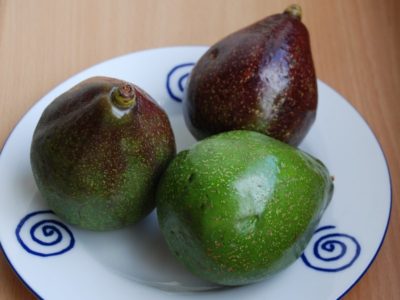
Avocado
Avocado originates from Southern Mexico and Central America.
The avocado is a very nutritious fruit. The fruits are not sweet, but have a fatty flavor and a creamy texture. Avocado is often used in salads and can be regarded as a vegetable. It is one of the most important tropical fruits.
Names
Scientific
Persea americana
Synonym
Persea gratissima
English
Alligator pear
Avocado
Avocado pear
Butter pear
Midshipman's butter
Dutch
Avocado
Spanish
Aguacate
French
Avocat
German
Avocado
Italian
Avocado
Taxonomy
Order
Laurales
Family
Lauraceae
Genus
Persea
Species
Persea americana (Avocado)
Basic information and facts
Origin:
Southern Mexico and Central America
Distribution:
Important in Central America as a food crop. In most tropical countries avocados are now grown either for home consumption or for local markets.
Evergreen or deciduous:
Avocado is an evergreen tree.
Flowers:
The small greenish-yellow flowers are 5 to 10 mm wide.
Leaves:
Avocado leaves are 12-25 cm long.
Fruits:
Avocado fruits are egg-shaped or pear-shaped. They are green, but may turn blackish when ripening.
Climate and weather:
Avocado requires a tropical or subtropical climates. The tree needs a climate without frost. It cannot tolerate strong winds.
Pollination:
Pollination is by insects, usually by bees.
Height:
Avocado trees are up to 20 meters tall.
Type of soil:
Can be grown on different types of soils but prefers deep
well aerated soils. Avocado cannot stand waterlogging so it requires good drainage. If there is a danger of waterlogging the trees should be planted on mounds.
Light:
Prefers full sun.
Spacing:
4 to 10 meters
Propagation:
The trees can be grown from seed but vegetative propagation by grafting is needed, as cultivars are very heterozygotous.
Insect pests:
Not many insect pests, but scale insects, mealybugs and mites may cause some problems.
Diseases:
Root rot (Phytophtora)
Harvesting:
The avocado fruit does get ripe on the tree. It can be picked in a hard, “green” but mature condition. After that it will ripen quickly in a few days time.
Chemical composition:
Avocados are very nutritious fruits with the highest energy value of all fruits. The flesh contains sugar, proteins and highly digestible oil which is very similar to olive oil. Avocados contain vitamins A, B and E.
Uses:
Ripe fruits are eaten fresh or used in salads. Avocado fruits are not sweet, but have a fatty flavor, and a smooth creamy texture. They have a higher fat content than other fruits. An unripe fruit is hard, but when ripe it will feel a bit soft when pressed in the palm of the hand. The flesh of ripe fruits has a typical greenish yellow to golden yellow color.
Did you know that?
Unlike other fruits, the avocado is not sweet, but it is very nutritious.
Recipes
Avocado with Tunafish
Ingredients:
3 ripe avocados, 200 gram tuna fish, 2 teaspoons lemon juice, 1 or 2 tablespoon mayonnaise (or mayonnaise mixed with yoghurt), salt, pepper
Instructions:
Cut the avocados lengthwise in halves and remove the seeds. To avoid discoloration treat the surface with some lemon juice. Mix the tuna fish with salt, pepper and mayonnaise and fill it in the avocado. Refrigerate it slightly before serving.
Simple avocado
Cut a ripe avocado lengthwise in halves and remove the seeds. Sprinkle with lemon juice, vinegar or Worcester sauce. Add salt and pepper.
Crop categories
Fruit vegetables
Fruits
Major crops
Subtropical crops
Tropical crops
Vegetables
Pictures

Avocado

Avocado open fruit

Avocado

Avocado young tree
